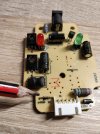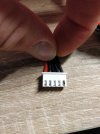- Joined
- Feb 8, 2021
- Messages
- 22
- Reaction score
- 2
- Age
- 26
I have the Eachine battery charger which I use to charge my XT60 75C 4S battery for my Eachine Wizard X200S drone - Eachine Wizard X220S FPV Racer RC Drone Spare Part 4S 14.8V Battery Charger
When I plugged my battery into it there was a spark and a burning smell and the charger no longer works. I have opened it up and it looks like a diode has blown. I got another one and used a different battery and the same thing happened again. I had used the new charger and the battery several times without an issue before it broke. Does anyone have any ideas as to why this is happening? I have the wall switch turned off when I plug the battery in but I can’t imagine that making a difference. There is a USA – UK plug adapter that came with the charger aswell. Also do you think that the battery that blew the charger is still safe to use? It had a slight burn mark on one of the terminals. The other battery that I blew it with has no marks at all.
Thank you
When I plugged my battery into it there was a spark and a burning smell and the charger no longer works. I have opened it up and it looks like a diode has blown. I got another one and used a different battery and the same thing happened again. I had used the new charger and the battery several times without an issue before it broke. Does anyone have any ideas as to why this is happening? I have the wall switch turned off when I plug the battery in but I can’t imagine that making a difference. There is a USA – UK plug adapter that came with the charger aswell. Also do you think that the battery that blew the charger is still safe to use? It had a slight burn mark on one of the terminals. The other battery that I blew it with has no marks at all.
Thank you




